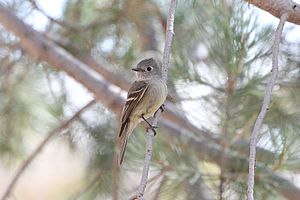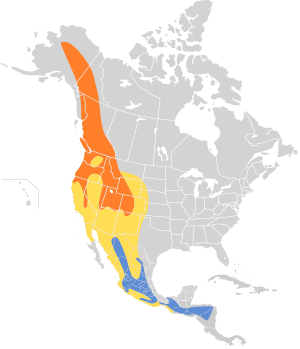Hammond's flycatcher facts for kids
Quick facts for kids Hammond's flycatcher |
|
|---|---|
 |
|
| Conservation status | |
| Scientific classification | |
| Genus: |
Empidonax
|
| Species: |
hammondii
|
 |
|
The Hammond's flycatcher (Empidonax hammondii) is a small bird that catches insects. It belongs to the tyrant flycatcher family. This bird lives in the coniferous (cone-bearing) and mixed forests of western North America. It is named after William Alexander Hammond, a surgeon in the US Army. He collected bird samples for a scientist named Spencer Fullerton Baird.
Contents
What Does a Hammond's Flycatcher Look Like?
Adult Hammond's flycatchers are about 12–14 cm (5 inches) long. Their wings spread about 22 cm (8.7 inches) wide. They usually weigh between 8 and 12 grams (0.3-0.4 ounces).
They have grayish-olive feathers on their back and whitish feathers underneath. Their wings and tail are darker. They have a clear white ring around their eyes and white bars on their wings. Their bill is small, and their tail is short. The chest often looks a bit gray, and the sides of their belly can be yellowish. Female birds usually have a shorter, wider bill than males. Young birds look similar to adults but have wider wing bars and are more buff-colored.
Many types of Empidonax flycatchers look very much alike. Hammond's flycatchers are often confused with the Dusky (E. oberholseri) and Gray (E. wrightii) flycatchers. These birds are similar in color and size and live in the same areas. The best way to tell a Hammond's flycatcher apart is by its unique call. You can also tell by where it builds its nest and where it lives.
About the Hammond's Flycatcher Family
Hammond's flycatchers are part of the Empidonax group, which includes about a dozen other species. Even though this bird lives in a large area, most Hammond's flycatchers are very similar genetically. This might be because their population became very small a long time ago.
However, some Hammond's flycatchers on Vancouver Island in British Columbia have changed. They have developed longer, thicker bills. This happened because Western flycatchers, which usually have thicker bills and use a similar habitat, are not found there. The Hammond's, Dusky, and Gray flycatchers are closely related species. They do not breed with each other.
Where Do Hammond's Flycatchers Live?
The Hammond's flycatcher is a migratory bird. This means it travels long distances. They breed in Western North America and spend their winters in Mexico and Central America.
Favorite Homes
These birds prefer to build their nests in old, mature coniferous (like pine or fir) and mixed forests. You can often find them in thick fir forests, or forests with conifers and aspen trees. Their winter homes are similar to their breeding grounds.
Where They Are Found
Hammond's flycatchers can be found in the Western United States. This includes states like Montana, Wyoming, California, Nevada, Utah, Arizona, New Mexico, and Colorado. In Canada, they live in British Columbia, Yukon, and Alberta. Some have even been seen as far north as Alaska. Their breeding areas were greatly shaped by past ice ages. These birds travel south for winter to Mexico and Central America.
How Hammond's Flycatchers Behave
Bird Calls and Songs
The song of the Hammond's flycatcher is a mix of rough sounds like ssilit, greeep, silit, and pweet. Their call is a sharp peek.
Hammond's flycatchers do not sing during their fall migration or in their winter homes. They start singing in early May, soon after they arrive at their breeding grounds. They sing more often and at a higher pitch at the start of the mating season. Males that do not have a partner sing more than those that have found a mate.
Like other Empidonax flycatchers, they sometimes snap their bills together. This is usually a warning sign to other birds.
What They Eat
Hammond's flycatchers love to eat insects. Their favorite foods include beetles, flies, bees, butterflies, and moths. These insects are usually small, about 5.7 mm long. They also eat other types of beetles and net-winged insects.
They wait on a high branch or in the middle of a tree. When they see an insect flying by, they fly out to catch it in mid-air. This is called hawking. Sometimes, they also pick insects off leaves while hovering, which is called gleaning.
Reproduction and Life Cycle
Hammond's flycatchers are believed to be monogamous. This means one male and one female stay together to raise their young. At the start of the breeding season, male Hammond's flycatchers sometimes fight. They lock together in the air and flutter to the ground.
They like to build their nests on high, small to medium-sized branches of tall trees. They prefer spots covered by leaves, usually on the northeast or southwest sides of trees. They also like old-growth forests, which are at least 80 to 90 years old.
They build a cup-shaped nest in a fork of a tree branch. Females usually lay three or four creamy white eggs in early June. These eggs sometimes have small reddish-brown dots. The female sits on the eggs for about 15 days to keep them warm. When the chicks hatch, they are altricial. This means they are born helpless and need a lot of care. Both the male and female parents help feed the young birds.
See also
 In Spanish: Mosquero de Hammond para niños
In Spanish: Mosquero de Hammond para niños



